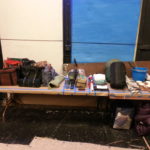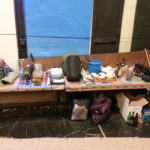For me designing props for a play is a process unique to each individual show. Most of the time when I read a script it will be immediately obvious to me what most of the props will be, what they’ll look like, where to get them or how to build them. For some unexplained reason this show was the exception. I read the script and it wasn’t immediately obvious, I mean yes there were some obvious props that were spelled out such as a bottle of Jack Daniels but there were so many things I couldn’t get the feel for—the images just weren’t coming. It was a scary and frustrating experience. So to overcome this “block” I decided to make a list of everything that was obvious and then wait to go to the reading of the script with all of the actors in place, I thought then I’ll get to know the character’s personalities better and get a feel for what sorts of items these people would use in their every day lives and in particular for this specific event in their lives. The reading cleared some things up, but not everything. After that I needed to balance what I wanted with what the director wanted and what would ultimately fit within the budget—which can be tricky with so many props called for. Through weeks of scouring the prop storage space at the theatre plus items borrowed from individual people and some shopping a cohesive design seemed to pull itself together, almost taking on a life of its own, it’s this part that I find most rewarding, the feeling of it come together…under budget (phew!).
The biggest challenge for me on this show believe it or not, was the champagne bottle. I struggled for weeks on what to do about it! Which is crazy, it’s just a fricken champagne bottle. But it wasn’t just a champagne bottle. At first it was going to be a champagne bottle that was going to be opened and the champagne was going to be poured into champagne glasses. This seems easy enough to make happen, just open a bottle of champagne and pour it, right?! Oh contraire, first we have the aforementioned budget to stay within, a new bottle of champagne for every show plus tech rehearsals will not achieve that goal. Second, it’s alcohol, which can come with its own set of issues. So real champagne was out and I needed to come up with a way to re-cork a bottle of champagne, fill it up with a carbonated beverage that would produce enough pressure to make the “pop” sound and have it look like actual champagne once poured. After days of playing with re-usable bottle stoppers, carbonated water and food dye I wasn’t getting the look and sound I wanted. Finally after I could not come up with anything else and was going crazy trying to figure it out my husband suggested instead of continuing to mess with the liquid inside why notget a different stopper—like magic, that solved most of my issues (he’s truly a genius)! I actually had a stopper in my house that allowed me to achieve the outside look I wanted and for the liquid I decided I would just fill the bottle up with sparkling cider, the only component that I really couldn’t achieve was the pop, without a good shake of the bottle which unfortunately would make a fantastic unwanted mess. It turns out that wasn’t necessary because the bottle never ends up getting opened. Sometimes it’s the simplest props that end up being the most challenging, which sometimes also ends up being the most rewarding.
Jen Cabarrus, Properties


